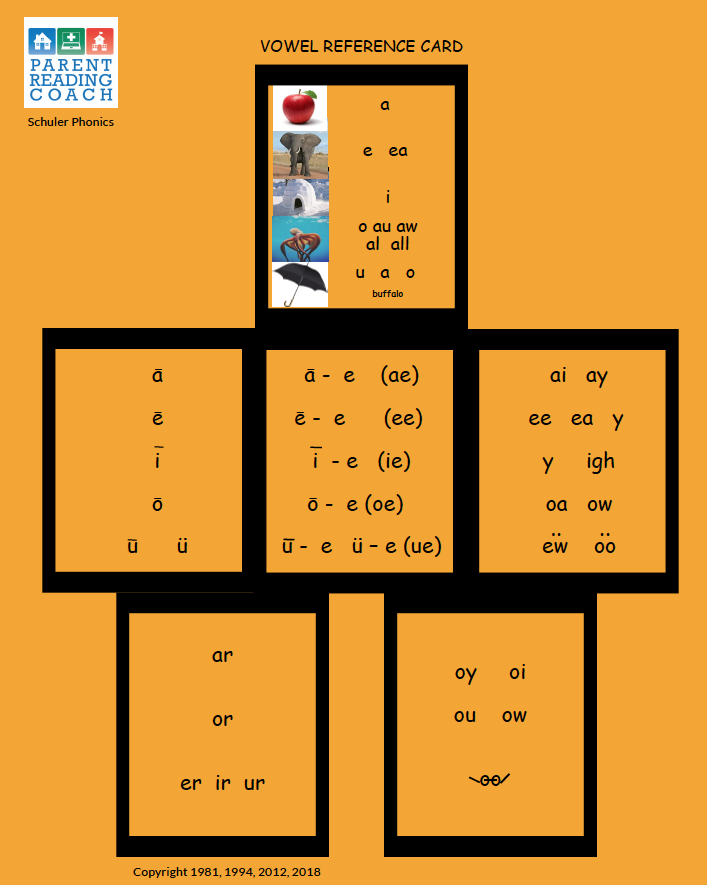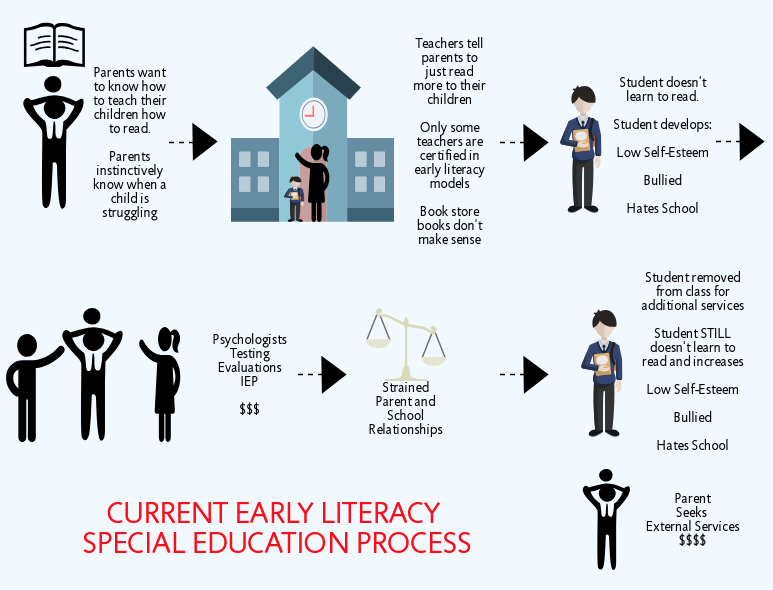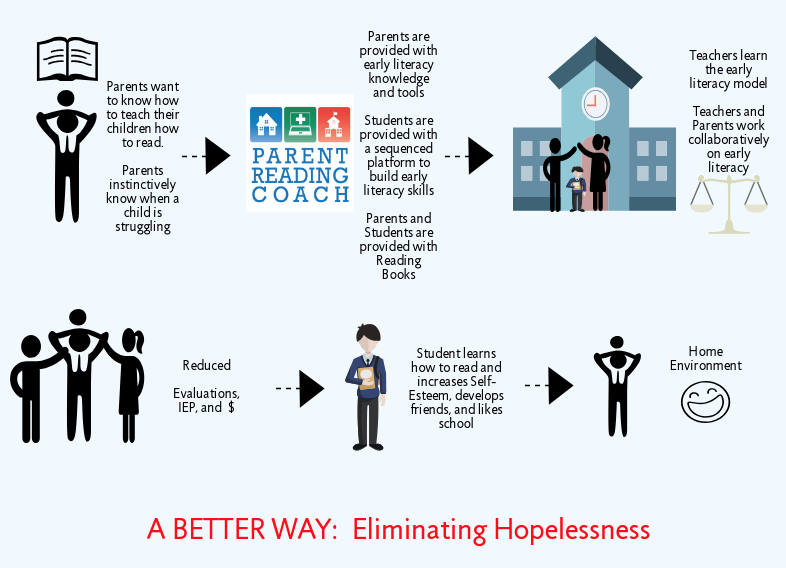Mission of Parent Reading Coach™
We believe in the power of parents to educate and guide their children in the learning process. We do this by giving parents the knowledge and tools necessary to decrease their dependence on formal educational systems.
We do this because we know millions of caring parents have voiced their frustrations on behalf of their children, who have been forced into a one-size-fits-all educational system. We do this because we demand an educational system that adapts to a child’s learning style, teaches them at their respective academic level, and allows them to pursue their academic passions and interests.
We do this because parents are asking for a roadmap to take control of their child’s educational experience.
For years I taught students to read the many different ways the vowel sounds are written by drilling flashcards, one by one. It often took a good student up to a month to memorize all those vowel sounds. Then, because that task was impossible for Kimie, a four-year-old, I invented my Vowel Reference Card.

It worked so well for her that I started allowing all of my students to use that card as a reference while they learned the common vowel sounds. Many students were able to master the sounds in less than a week, sometimes in just one lesson, and then they were able to start applying that knowledge to actual words.
My journey of more than 50 years of working as a regular and special education teacher, along with doing specialized one-on-one tutoring with parents as part of the process, has resulted in the creation and publishing of my own materials. When I couldn’t find materials to teach a child, I would just create them myself. For reading, I used the Orton-Gillingham Method as my base. For math, I used right-brain, hands-on, manipulatives, and some I created myself, to simplify concepts. Always, the materials I created came from a student’s need, one I couldn’t meet using the teaching materials that were currently available. I created my materials for students first, then I wrote them up formally for parents and teachers.
I’ve published my materials for parents for two main reasons:
- Teachers, based upon my personal experience as a teacher and trainer of teachers, are driven by school priorities (requirements to use the materials provided to them from school districts) and the difficulty in working individually with students, especially when classroom sizes are large. How well I am aware of that! I was trained as an elementary teacher (1965) and taught Kindergarten, 1st grade, a composite of the lower grades, and then 5th grade. I remember so very well, watching some of my 5th graders, struggling to learn, and yet, being so very aware, that I didn’t have the time to meet with them individually and help them with these struggles. The summer, after I taught 5th grade, I went for my Master’s Degree in Reading and Special Education. Even then, after increasing my knowledge of what I needed to do to help my struggling students, I just couldn’t find the time to do the job in the classroom, both in my 6th grade classroom the next year or the year after that when I went on to teach in a composite Special Education classroom. In an effort to address the need I saw firsthand, I began tutoring, one-on-one, with parents as my helpers.
- Parents, when directly participating in the process, by being present at each lesson and later practicing the lessons with their child between tutoring sessions, proved to be an awesome support in the process. I’ve told many a parent they needed to take credit for the job accomplished because without their help, yes, I might have done as well, but it would have taken me so much longer to accomplish our goals. Plus, when my job was done, the parents had a communication system concerning reading/math/writing with their own child, so they could continue to be a part of their child’s education.
Problem from a Parent’s Perspective
Special Education
The current processes provided by schools, as illustrated below, result in money being spent on evaluations and the development of Individualized Educational Plans (IEPs) with few adapted and specialized instructional services for the student. Given that close to one in five students in English-speaking countries has a language-based learning disability, dyslexia being the most common, we understand that 20 percent of the population needs alternative solutions.
When solutions depend solely on teachers, we experience additional barriers. Teachers have said, “Teaching children is the role of schools,” mainly because they have their hands full in teaching the children and do not have the time to teach parents how to teach their own children. They encourage parents to read to their children (awesome advice), but parents also need early literacy knowledge and tools if they are going to be part of the process, and ultimately part of the solution.
Children Entering School Ready to Read
Parents who want to assist in the early literacy preparation for their children often find too much information, information that often appears to be building on random skills, resulting in parents being kept in the dark on how to teach their own children to read.

A Better Way: Giving Parents the Knowledge and Tools
Although the solution is simple -- training parents to be part of the early literacy and math instruction for their own children -- the challenge was, and is, to create a model or system that engages and provides parents with the proper knowledge and tools to teach their children how to read.
Not knowing exactly where to start, I simply started with the belief that parents needed the knowledge and tools if they were going to teach their own children. The process can be complicated, but my system has simplified that. If I could reach the parents then students would actually learn how to read in a timely manner, and I could save schools lots of money.
Initially, I taught my methods at a university to both teachers and parents, but the ability to reach many was prohibitive because of time and cost requirements. After numerous conversations with teachers, schools, and parents, and multiple adaptations, Parent Reading Coach™ was born. Parent Reading Coach™, illustrated below, is based upon the premise that all children can read when parents use research-informed learning techniques and strategies; every child is valued for his or her uniqueness and able to learn at his or her respective academic level; and parents shift from delivering content to being facilitators of learning. Parent Reading Coach™ provides training videos and a virtual student platform to caregivers and students. Through this system, vested parents and caregivers have access to the tools and knowledge necessary to help their children learn to read. Parent Reading Coach™ uses a cloud-based platform that can be used to disseminate material to students, parents, and teachers, as well as administer reading-based learning challenges. The program moves sequentially and prevents students from progressing until they demonstrate mastery through parent engagement. Additionally, this model allows students to build their own skills, and teaches them the foundations of reading by practicing and progressing without relying entirely on their parents and teachers. Finally, Parent Reading Coach™ has adapted to include the distribution of hardcopy books that students and parents determined are needed in order to support their success, thereby providing physical materials in addition to an online platform.

Early Literacy Eight-Step Model
I learned that consonant sounds are not much of a problem as the schools do a good job of introducing those sounds, and most students do well when learning them. Vowel sounds, however, are written many different ways and are not grouped in ways that make sense to students. For this reason, most reading programs are structured upon the ability of the student to recognize vowel patterns and depend highly on memorization.
Step 1: With much help, I organized my reading program into an eight-level systematic approach with my vowel reference card being the centerpiece. This eight-step process allows parents and students to teach and learn a system that is now manageable for both.
Description of the Eight-Step Process:
- Association of eight consonants and two short vowel sounds.
- Joining of beginning consonants with short vowels. Flow 1 and Flow 2.
- Joining of all single letter beginning and end consonants with the five short vowels. Flow 1 and Flow 2.
- Association of blends with short vowel sounds. Flow 1 and Flow 2.
- Joining of digraphs with short vowel sounds. Flow 1 and Flow 2.
- Silent E Rule.
- Vowel Reference Card: Flow 1 and Flow 2, including the deep dive video: One of my students, Joseph, in addition to my other students was required to say all of the possible sounds for the common vowel sounds and circle them on his papers, because by doing so, even if he knew the word, he was practicing the possible vowel sounds for the letter/letters over and over. When students did come to an unknown word, and the first sound didn’t work, they could quickly try the other possible sounds to figure out the word. English is a guessing game! Just because you see the letter "a" in a word doesn’t mean it will say the short a sound as in apple /a/. It might say the long a sound as in maple or even the short "u" sound as in around. If students learn to guess and guess quickly, they can figure out how to read a word without having to look that word up in a dictionary.
Once my Vowel Reference Card is mastered students can learn to read easy words such as Joseph was required to read, nonsense syllables as “com” in the word combination, and later multisyllabic words. I use the same Vowel Reference Card to help students learn to spell. For example, a student who doesn’t know how to spell the word “flown” as in, “The airplane had flown over the house three times,” but knows that long "o" could be spelled with just an "o," with an "e" added at the end (silent e rule), "oa," or "ow," is taught to write out those sounds as "flon," "flone," "flown," and "floan.” Most times, once written, the student can pick the correct spelling because a student’s reading level is often one to two years higher than their spelling level. - Reading Multisyllable Words.
Step 2: We created Parent Reading Coach™ as an online accessible platform for Schuler Phonics where each level is accompanied by a tutorial video. This tutorial is targeted for the parent/teacher and is in the format of a short training video. Essentially it provides the parent with the logic behind the construction of the English reading building blocks.
Step 3: We created the Parent Reading Coach™ practice application to ensure fidelity to the process. Altogether, the Parent Reading Coach™ practice application takes a student through eight levels, 13 reading building blocks, leading to their ability to read many English language words. Upon completion of the activities in the practice application, Parent Reading Coach™ sends the parent an email to assess mastery before the student can move onto the next level. Mastery Assessment Guides are in the parent log-in platform in the form of pdf files.
Note: A parent can bypass this process by simply logging in and assigning the student a new level. However, we strongly recommend that the parent print out the Mastery Assessment Guides and complete them with the student. Key to success in the reading process is having a student practice the skills in a “pencil/paper” environment, one-on-one with the parent. These Mastery Assessment Guides are taken from my Schuler Phonics CORE (2nd Part) materials.
Step 4: Aware that holding a physical book is still an important aspect of learning to read, we are publishing early literacy books that follow my systematic, sequential approach. After an exhaustive search, we found that many early literacy books are frustrating to kids because the words are not well-controlled, some being difficult even in beginning books. Some books have controlled vocabulary and do an excellent job of introducing the consonants, short vowels, and silent e rule, but then they jump and add multiple vowel sounds with little or no instruction as to how the students are to remember all those vowel sounds. Our early literacy books, not only are written with the short vowels and silent e words, but using the Vowel Reference Card, give the readers a way to sound out and remember those more difficult vowel sounds. Our favorite literacy series is the SRA Dolch Readers, but this series does not cover the beginning stages of reading so it is too advanced for beginner readers. Students need something before this series. Our “Learn to Read Phonetically” series of books feed into this Dolch series, providing pre-requisite skills as an early essential step.
Step 5: We are offering virtual webinars at an affordable cost to parents to support our providing an in-person expert and contact to answer any questions regarding their children’s learning.
Conclusion
Parent Reading Coach™ offers an evidence-informed (Orton-Gillingham), virtual training and early literacy platform for students with learning disabilities. The program is both accessible and affordable, and it is targeted directly towards parents and caregivers. This type of learning system offers promising, new ways of learning that could transform those currently labeled as “non-academics” into flourishing, confident self-learners.
Ultimately, Parent Reading Coach™ envisions a world in which all children are literate. This model also pushes for motivated teachers to acquire early literacy training, which is often excluded from their higher education degrees. Parent Reading Coach™ might not ensure literacy for everyone, but it does provide the essential knowledge and tools necessary to eliminate the hopelessness that many parents experience when their child does not fit into the traditional educational system.
Parent Reading Coach™ continues to evolve based on consumer-driven feedback. For more information on Parent Reading Coach™ visit: www.parentreadingcoach.org.


